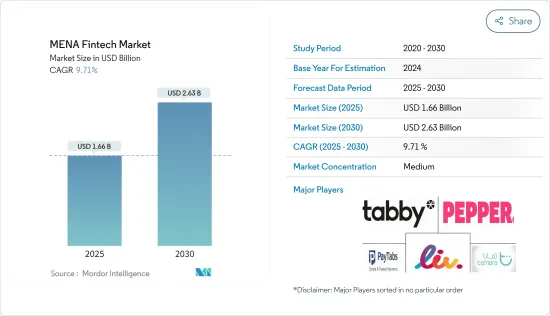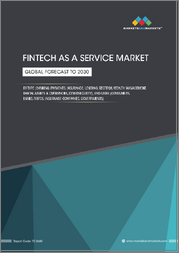
|
시장보고서
상품코드
1690894
중동 및 북아프리카의 핀테크 시장 : 시장 점유율 분석, 산업 동향 및 통계, 성장 예측(2025-2030년)MENA Fintech - Market Share Analysis, Industry Trends & Statistics, Growth Forecasts (2025 - 2030) |
||||||
중동 및 북아프리카의 핀테크 시장 규모는 2025년에 16억 6,000만 달러로 추정되고, 예측 기간(2025-2030년) 중 CAGR 9.71%를 나타낼 전망이며, 2030년에는 26억 3,000만 달러에 달할 것으로 예측됩니다.

중동에서는 핀테크 부문이 급성장하고 있습니다. 결제 프로세서, 핀테크 기업, 플랫폼이 기존의 금융 상황을 파괴하고 국내 시장과 세계 시장 모두에 침투하고 있습니다. 이 성장의 주요 원동력이 되고 있는 것은 이 지역이 기술을 신속하게 받아들이고 있다는 것입니다.
한 보고서에 따르면, 중동 및 북아프리카 지역, 특히 아랍에미리트(UAE), 사우디아라비아, 바레인, 이집트는 핀테크의 자금 조달 진원지입니다. 이 나라들은 이 지역 투자의 경이로운 99%를 차지하고 있습니다. 핀테크 부문에서는 결제 솔루션이 선도하며 전체 투자액의 42%를 차지하고 연간 성장률은 152%라는 경이로운 숫자를 자랑하고 있습니다. 이 보고서는 또 2030년까지 중동에서 45개 이상의 핀테크 신흥기업이 설립되고 각각의 기업가치가 10억 달러 이상이 될 것으로 전망하고 있으며 사우디아라비아가 이 동향에 앞장서고 있습니다.
2023년 시점에서 중동과 북아프리카은 250개가 넘는 핀테크 신흥 기업을 자랑하며, 그 수는 2025년까지 250개를 넘을 것으로 예측되고 있습니다. 중동 및 북아프리카의 강고한 창업 에코 시스템은, 핀테크를 이 지역의 임박한 금융 허들에 임하는 중요한 참가 기업으로서 평가하고 있습니다.
세계적으로 금융정세가 어려운 가운데 중동 및 북아프리카의 핀테크 산업은 다른 산업을 능가하는 회복력을 보였습니다. 금리 상승과 기술적 혼란에 상징되는 세계 경기 침체에도 불구하고 중동과 북아프리카의 핀테크 분야는 자금 조달 총액이 전년 동기 대비 47% 감소한 4억 8,400만 달러에 그쳤습니다. 그러나 이 분야의 SEED 평가액은 안정적이며, 그 안정성을 뒷받침하고 있습니다.
중동 및 북아프리카의 핀테크 시장 동향
디지털 및 캐시리스 결제 증가가 시장 성장을 견인
중동 전역에서는 디지털 결제, 국경을 넘은 즉시 결제, BPL(buy-now-later) 서비스, 디지털 뱅킹이 시장을 독점하고 있습니다. 중동 및 북아프리카 지역에서는 정부의 뒷받침 및 디지털 경제화의 추진으로 디지털 결제가 급증하고 있습니다. 중동 및 북아프리카의 핀테크 기업의 85% 이상이 결제 및 송금 서비스에 주력하고 있습니다.
Gpay, Apple Pay, Samsung Pay 등 세계 결제 대기업의 진입은 중동 및 북아프리카에서 디지털 월렛의 보급에 박차를 가했습니다. 주목할만한 것은 아랍에미리트(UAE)가 현금없는 사회로의 세계적 변화의 전면 러너로 부상했다는 것입니다. 데이터에 따르면 아랍에미리트(UAE) 중소기업의 70%가 이미 현금없는 시스템을 도입했거나 2024년까지 도입할 예정입니다.
Visa의 최신 데이터는 캐쉬리스 사회 도입에서 아랍에미리트(UAE)의 선구적인 자세를 강조하고 있습니다. 아랍에미리트 소비자의 주목할 만한 52%는 세계 평균 41%를 상회하며 2024년까지 캐시리스 라이프스타일을 이미 도입했거나 이행할 예정입니다. 전자상거래 부문에서는 신용카드가 중심적인 지위를 차지하며 거래의 대부분을 차지하고 있습니다. 반면 체크카드는 FIS Global Payments Wallet이 강조하는 것처럼 시장의 11%를 차지하고 있습니다. 게다가 모바일 지갑을 포함한 온라인 결제는 총 거래액의 24%라는 큰 비중을 차지하고 있어 아랍에미리트에서 두 번째로 인기가 높은 결제 수단으로 입지를 굳히고 있습니다.
아랍 에미리트 연합이 핀테크 시장 석권
아랍에미리트(UAE)의 핀테크 분야에 대한 투자는 2024년에 92%라는 경이적인 급증을 보였으며, 2028년까지 거래액이 두배가 될 것이라고 예측도 나오고 있습니다. 이러한 급증은 아랍에미리트의 전략적인 지리적 위치, 현지 주민의 핀테크 솔루션에 대한 의욕의 고조, 외국 직접 투자(FDI)의 매력 등, 복수의 요인에 의지하고 있습니다.
아랍에미리트(UAE) 정부는 세금 혜택을 통해 그린 핀테크의 노력에 적극적인 인센티브를 부여하고 있습니다. 이 움직임은 혁신을 촉진하고 금융 성장을 강화하며 환경 지속 가능성에 대한 국가의 약속을 강조하는 것을 목적으로 하고 있습니다. 특히 아랍에미리트는 암호화폐 거래소와 FX/CFD 브로커를 포함한 금융 서비스 공급자들에게 좋은 장소로 떠오르고 있습니다. 세계 유수의 경제성장률을 자랑하는 아랍에미리트 정부는 혁신을 지원하고 투자를 유치하는 시책을 채택하고 있습니다. 이러한 시책은, 외국인 투자가에 대한 세제 우대 조치나, 국가의 투자 가능성과 적당한 생활을 강조하는 정곡을 찌른 광고 캠페인에 미치고 있습니다.
중동 및 북아프리카의 핀테크 산업 개요
중동 및 북아프리카의 핀테크 시장은 적당히 세분화되어 있습니다. 세계의 기업이 이 부문에 다액의 투자를 실시하고 있습니다. 중동 및 북아프리카 시장에서는 시장 점유율은 작지만 많은 핀테크 기업이 존재합니다. 핀테크 플랫폼의 채택과 신기술로의 업그레이드의 필요성으로 인해 기업 간의 경쟁이 격화되고 있습니다. 팬데믹과 도시의 대두로 사람들은 새로운 지불 방법과 비접촉 게이트웨이를 받아들이기 시작했습니다. 혁신과 기술 진보는 가속화되었습니다. 시장을 독점하고 있는 주요 기업으로는 Tamara, Liv., Pepper, PayTabs, Tabby, 및 Sarwa 등이 있습니다.
기타 혜택
- 엑셀 형식 시장 예측(ME) 시트
- 3개월간의 애널리스트 서포트
목차
제1장 서론
- 조사의 전제조건 및 시장 정의
- 조사 범위
제2장 조사 방법
제3장 주요 요약
제4장 시장 역학 및 인사이트
- 시장 개요
- 시장 성장 촉진요인
- 전자상거래 및 모바일 뱅킹 플랫폼에 대한 고객의 요구 증가
- 인터넷 보급률 상승 및 스마트폰 보급이 계속 시장 성장 견인
- 시장 성장 억제요인
- 데이터 프라이버시에 대한 우려
- 사이버 보안 위험 증가
- 시장 기회
- 핀테크 신흥 기업에 대한 투자 증가
- 로보 어드바이저는 앞으로도 계속 성장 전망
- 산업의 매력-Porter's Five Forces 분석
- 구매자의 협상력
- 공급기업의 협상력
- 신규 참가업체의 위협
- 대체품의 위협
- 경쟁 기업간 경쟁 관계
- 시장 기술 혁신 인사이트
- 정부 규제 및 시책에 관한 인사이트
- 시장에 대한 COVID-19의 영향
제5장 시장 세분화
- 서비스 제안별
- 송금 및 결제
- 저축 및 투자
- 디지털 대출 및 대출 시장
- 온라인 보험 및 보험 시장
- 기타 서비스 제안
- 국가별
- 아랍에미리트(UAE)
- 사우디아라비아
- 바레인
- 카타르
- 이란
- 이집트
- 이스라엘
- 기타 중동 및 북아프리카 국가
제6장 경쟁 구도
- 시장 집중 개요
- 기업 프로파일
- Tamara
- Liv.
- Pepper
- PayTabs
- Tabby
- Sarwa
- Ila Bank
- Bayzat
- Eureeca
- Cwallet*
제7장 시장 기회 및 향후 동향
제8장 면책사항 및 출판사에 대해서
AJY 25.05.09The MENA Fintech Market size is estimated at USD 1.66 billion in 2025, and is expected to reach USD 2.63 billion by 2030, at a CAGR of 9.71% during the forecast period (2025-2030).

The Middle East is witnessing a surge in its fintech sector. Payment processors, fintech firms, and platforms are disrupting the traditional financial landscape, penetrating both domestic and global markets. A key driver behind this growth is the region's swift embrace of technology.
According to a report, the MENA region, particularly the United Arab Emirates, Saudi Arabia, Bahrain, and Egypt, is the epicenter of fintech funding. These nations accounted for a staggering 99% of the region's investments. Within the fintech sector, payment solutions took the lead, capturing 42% of all investments and boasting a remarkable annual growth rate of 152%. The report also predicts the launch of over 45 fintech startups, each valued at USD 1 billion or more, in the Middle East by 2030, with Saudi Arabia spearheading this trend.
As of 2023, the MENA region boasted over 250 fintech startups, a number projected to surge beyond 250 by 2025. MENA's robust entrepreneurial ecosystem positions fintech as a key player in tackling the region's pressing financial hurdles.
In the face of a challenging global financial landscape, MENA's fintech industry showcased resilience, outpacing other sectors. Despite a global economic downturn marked by rising interest rates and technological disruptions, MENA's fintech sector witnessed a 47% Y-o-Y dip in total funding, settling at USD 484 million. However, the sector's SEED valuation remained steady, underscoring its stability.
MENA Fintech Market Trends
Rising Digital & Cashless Payments is Driving the Growth of The Market
Across the Middle East, digital payments, cross-border instant payments, BPL (buy-now-later) services, and digital banking reign the market. The MENA region witnesses a surge in digital payments, bolstered by government backing and a push towards a digital economy. Over 85% of fintech firms in the MENA region focus on payment and transfer services.
The entry of global payment giants like Gpay, Apple Pay, and Samsung Pay fueled a surge in the adoption of digital wallets in MENA. Notably, the United Arab Emirates has emerged as a frontrunner in the global shift towards cashless societies. Data suggests that 70% of SMEs in the UAE have already embraced or are poised to adopt cashless systems by 2024.
Recent data from Visa underscores the UAE's pioneering stance in adopting a cashless society. A notable 52% of UAE consumers, outpacing the global average of 41%, are either already embracing or planning to transition to a cashless lifestyle by 2024. Within the e-commerce realm, credit cards take center stage, dominating the landscape and accounting for the majority of transactions. Debit cards, on the other hand, make up 11% of the market, as highlighted by FIS Global Payments Wallet. Additionally, online payments, including mobile wallets, constitute a significant 24% of the total transaction value, solidifying its position as the UAE's second most popular payment method.
UAE is Dominating the Fintech Market
Investment in the UAE's fintech sector has surged by an impressive 92% in 2024, with projections indicating a doubling of transaction value by 2028. This surge is underpinned by multiple factors, including the UAE's strategic geographic location, a rising appetite for fintech solutions among locals, and its allure for foreign direct investment (FDI).
The UAE government is actively incentivizing green finTech initiatives through tax benefits. This move aims to foster innovation, bolster financial growth, and underscore the nation's commitment to environmental sustainability. The UAE, particularly, is emerging as a favored destination for financial service providers, including cryptocurrency exchanges and FX/CFD brokers. With one of the world's swiftest-growing economies, the UAE's government has embraced policies that champion innovation and attract investments. These measures span tax incentives for foreign investors and targeted ad campaigns highlighting the nation's investment potential and affordable living.
MENA Fintech Industry Overview
The MENA fintech market is moderately fragmented. Companies from all over the world are investing heavily in this segment. In the MENA market, there are many fintech companies with smaller market shares. The adoption of fintech platforms and the need to upgrade to new technology increases the competition among companies. Due to the pandemic and the rise of cities, people started to accept new methods of payment and contactless gateways. Innovation and technological progress accelerated. Some of the major players dominating the market include Tamara, Liv., Pepper, PayTabs, Tabby, and Sarwa.
Additional Benefits:
- The market estimate (ME) sheet in Excel format
- 3 months of analyst support
TABLE OF CONTENTS
1 INTRODUCTION
- 1.1 Study Assumptions and Market Definition
- 1.2 Scope of the Study
2 RESEARCH METHODOLOGY
3 EXECUTIVE SUMMARY
4 MARKET DYNAMICS AND INSIGHTS
- 4.1 Market Overview
- 4.2 Market Drivers
- 4.2.1 Customers' Growing Need for E-Commerce and Mobile Banking Platforms
- 4.2.2 Rising Internet Penetration & Adoption of Smartphones will Continue to Lead the Growth of the Market
- 4.3 Market Restraints
- 4.3.1 Data Privacy Concerns
- 4.3.2 Increasing Cybersecurity Risks
- 4.4 Market Opportunities
- 4.4.1 Rising Investments in Fintech Startups
- 4.4.2 Robo-Advisors Will Continue to Grow in the Future
- 4.5 Industry Attractiveness - Porter's Five Forces Analysis
- 4.5.1 Bargaining Power of Buyers
- 4.5.2 Bargaining Power of Suppliers
- 4.5.3 Threat of New Entrants
- 4.5.4 Threat of Substitutes
- 4.5.5 Intensity of Competitive Rivalry
- 4.6 Insights of Technology Innovations in the Market
- 4.7 Insights on Government Regulations and Industry Policies
- 4.8 Impact of COVID-19 on the Market
5 MARKET SEGMENTATION
- 5.1 By Service proposition
- 5.1.1 Money Transfer and Payments
- 5.1.2 Savings and Investments
- 5.1.3 Digital Lending & Lending Marketplaces
- 5.1.4 Online Insurance & Insurance Marketplaces
- 5.1.5 Other Service Propositions
- 5.2 By Country
- 5.2.1 United Arab Emirates
- 5.2.2 Saudi Arabia
- 5.2.3 Bahrain
- 5.2.4 Qatar
- 5.2.5 Iran
- 5.2.6 Egypt
- 5.2.7 Israel
- 5.2.8 Rest of MENA
6 COMPETITIVE LANDSCAPE
- 6.1 Market Concentration Overview
- 6.2 Company Profiles
- 6.2.1 Tamara
- 6.2.2 Liv.
- 6.2.3 Pepper
- 6.2.4 PayTabs
- 6.2.5 Tabby
- 6.2.6 Sarwa
- 6.2.7 Ila Bank
- 6.2.8 Bayzat
- 6.2.9 Eureeca
- 6.2.10 Cwallet*



















